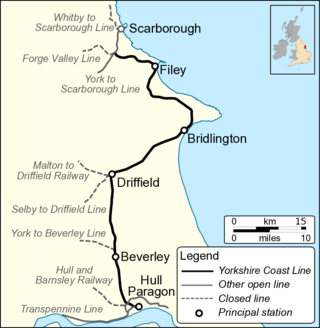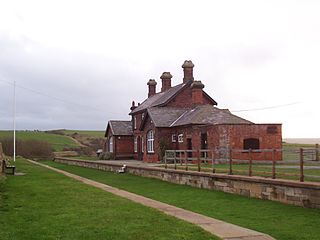
Malton railway station is a Grade II listed station which serves the towns of Malton and Norton-on-Derwent in North Yorkshire, England. Situated on the York-Scarborough Line, it is operated by TransPennine Express, who provide all passenger train services. Once an interchange between four lines, Malton station is now only served by trains operating between York and Scarborough. The station itself is south of the River Derwent, and is actually in the town of Norton in the East Riding of Yorkshire, which for many years was in a different county to Malton.

The Hull–Scarborough line, also known as the Yorkshire Coast Line, is a railway line in Yorkshire, England that is used primarily for passenger traffic. It runs northwards from Hull Paragon via Beverley and Driffield to Bridlington, joining the York–Scarborough line at a junction near Seamer before terminating at Scarborough railway station.

Pickering railway station is the southern terminus of the North Yorkshire Moors Railway and serves the town of Pickering in North Yorkshire, England. The first railway arrived in Pickering from the north in 1836, however, it wasn't until the railway was connected from the south in 1845, that the current station was built. The station was closed by British Railways in March 1965, but since 1975, the station has served as the southern terminus of the North York Moors Railway.

Rillington railway station was a railway station serving the village of Rillington in North Yorkshire, England and on the York to Scarborough Line. It was also the junction station for the line to Whitby and was opened on 5 July 1845 by the York and North Midland Railway. It closed to normal passenger traffic on 22 September 1930, but was used by special trains until the 1960s. The goods yard was closed on 10 August 1964. The station building has been converted to a private house but the remainder of the station has now been demolished.

The Malton and Driffield Junction Railway, later known as the Malton and Driffield branch was a railway line in Yorkshire that ran between the towns of Malton, North Yorkshire and Driffield in the East Riding of Yorkshire.

Ravenscar was a railway station on the Scarborough & Whitby Railway and served the village of Ravenscar, North Yorkshire, England.

Fyling Hall railway station was a railway station on the Scarborough & Whitby Railway. It opened on 16 July 1885, and was named after Fyling Hall, near Fylingthorpe. It was a small rural station with one platform, serving a catchment of less than 200 people.

Robin Hood's Bay railway station was a railway station on the Scarborough & Whitby Railway situated 15 miles (24 km) from Scarborough and 6 miles (9.7 km) from Whitby It opened on 16 July 1885, and served the fishing village of Robin Hood's Bay, and to a lesser extent the village of Fylingthorpe. On the north-bound journey trains had to climb a mile and a half at 1-in-43 out of the station.

Whitby West Cliff railway station was a railway station on the Whitby Redcar and Middlesbrough Union Railway. It was opened on 3 December 1883, to serve the West Cliff area of the town of Whitby, North Yorkshire, England. It was one of two stations serving Whitby; the other was Whitby Town railway station, which served the lines to Malton and Battersby.

Kettleness was a railway station on the Whitby, Redcar and Middlesbrough Union Railway from 1883 to 1958 serving the remote village of Kettleness. The main station building is still extant and serves as a scouting centre.

Hinderwell railway station was a railway station on the Whitby Redcar and Middlesbrough Union Railway. It was opened on 3 December 1883, and served the villages of Hinderwell and Runswick Bay. Like most stations on the line between Loftus and Whitby West Cliff, it was built with a passing loop. However, the northbound side was not furnished with a platform until 1908. The station closed to all traffic on 5 May 1958.

Staithes railway station was a railway station on the Whitby Redcar and Middlesbrough Union Railway, serving the villages of Staithes and Dalehouse in North Yorkshire, England. It was opened on 3 December 1883.

Beckhole railway station was a railway station at Beck Hole in the North Yorkshire Moors on part of the original Whitby and Pickering Railway line. Although it was possible to travel to Beckhole in 1835, the station was opened in 1836, and closed to passengers permanently in 1914. Beckhole closed completely in 1951.

Helmsley railway station served the market town of Helmsley in North Yorkshire from 1871 until 1964, although the regular passenger service ceased in 1953. Helmsley station was nearly 15 miles (24 km) from Pilmoor station on the East Coast Main Line, and 12 miles (19 km) from Pickering.

The Thirsk and Malton line was a railway line that ran from a triangular junction on what is now the East Coast Main Line and served eight villages between Thirsk and Malton in North Yorkshire, England. The line was built after a protracted process due to inefficiencies and financial problems suffered by the then York and North Midland Railway.
Gallows Close goods yard was a freight transfer yard on the Scarborough and Whitby Railway in the town of Scarborough, North Yorkshire, England. The yard was opened in 1899 to relieve pressure on the main station in Scarborough and to release space for passenger use. After the Scarborough and Whitby Railway closed down, Gallows Close remained in use as a goods yard until final closure came in 1985.

Whitby engine shed was a steam locomotive depot located at the south end of Whitby railway station in North Yorkshire, England. The shed was opened in 1847, extended in the 1860s, and closed in 1959, when the closure of lines and dieselisation of the routes from Whitby took hold. The shed building, which was grade II listed in 1991, still stands, being utilised for various enterprises, and is now used as holiday accommodation.

Prospect Hill Junction was a railway junction in Whitby, North Yorkshire, England. The junction had access to the line into Whitby Town railway station, Whitby West Cliff railway station, and also to the Scarborough line, which went south across Larpool Viaduct. It first saw traffic in December 1883, but did not open as a junction until 1885. It was closed to passenger and freight traffic in March 1965, though the lines were not lifted until 1973.
Scarborough engine sheds are two locations used to service locomotives in the town of Scarborough, North Yorkshire, England. The first location was used between 1845 and 1963, and thereafter, locomotives were stabled within the station. In 2019, TransPennine Express opened up a new single road facility to service their leased Class 68 locomotives used on the Liverpool to Scarborough services.

Beckhole Incline was a steep, rope-worked gradient on the railway line between Whitby and Pickering, in the North Riding of Yorkshire, England. Opened in May 1836 as part of the horse-worked Whitby & Pickering Railway, the line was operated by three railway companies before becoming redundant on the opening of a diversionary line to the east that allowed through working by steam engines on the entire line. Although the incline was closed to regular traffic in 1865, it was used for a very brief period in 1872, to test a special locomotive intended for railways with steep gradients.


















